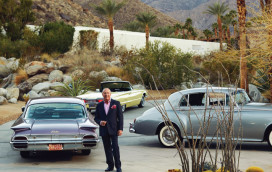“I was an army brat and traveled all over the world with my father to places like Burma,” the 48-year-old says. “Wherever we went we’d take at least 25 trunks. To me, that was how people traveled.”
When the designer joined Moynat in 2011 from Hermès, where he’d worked for ten years under Martin Margiela and Jean Paul Gaultier, the LVMH accessories brand offered the perfect link between private passion and professional career: Nair owns more than 200 antique trunks. Moynat, which was launched in 1849 by Pauline Moynat, who sold travel goods, and trunk-making brothers Octavie and François Coulembier, was one of France’s oldest trunk-makers, with a reputation for innovation. “In 1870, it brought out a lightweight trunk using a wicker frame instead of a metallic one,” Nair explains. It was also, he adds, the first to use hardened gutta-percha waterproofing as well as varnished canvas and leather trimming.
What appeals most to Nair, though, is the manner in which trunks were customized. “There were all sorts of styles made,” he explains. “The limousine style was curved to fit on to a car roof; the cabin trunk opened in front and slid under the berth; while automobile trunks attached to the back of the car, before the trunk as we know it today was devised.”
The first trunk Nair ever bought, in Chantilly in France, was “a real fluke”, he admits. Although it was in fantastic condition, its owner was desperate to get rid of it. “Because it was arched, she couldn’t use it as a table and it was just gathering dust in the garage,” he says. “So I got it for only around $270.” A contemporary Moynat trunk, on the other hand, will set you back several thousand dollars.
Other unexpected finds have been a 1907 cabin trunk from Marseilles, with its key still in the lock, and an ugly black trunk found in Rennes. “After stripping and cleaning it, it turned out to be a lovely dark green, which, I then discovered, matched the car that it was originally designed for.”
“I am fascinated by the idea of the customer asking for a certain color and a certain number of locks, and the reason they wanted them,” he continues. “I always wonder what adventure they were going to have.”
His favorite models are those from the Belle Epoque, which he describes as “real couture pieces, because no trunk is similar to another”. But these are becoming increasingly difficult to find. “I have contacts all over Europe – France and England are the best sources. But really lovely ones are becoming a rarity, which makes the ones I already have even more precious.”
Box Clever
Words by Natasha Fraser-Cavassoni | Photographed by Anne Deniau– The Connoisseur –
Not many executives of high-end accessories companies cycle to work in the morning.
But Ramesh Nair, the Indian-born creative director of Moynat trunk-makers in Paris,
has a different sense of what “normal” is



